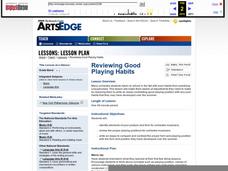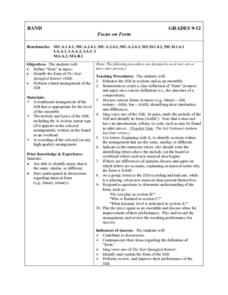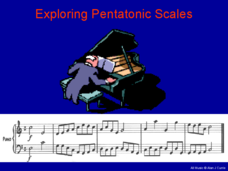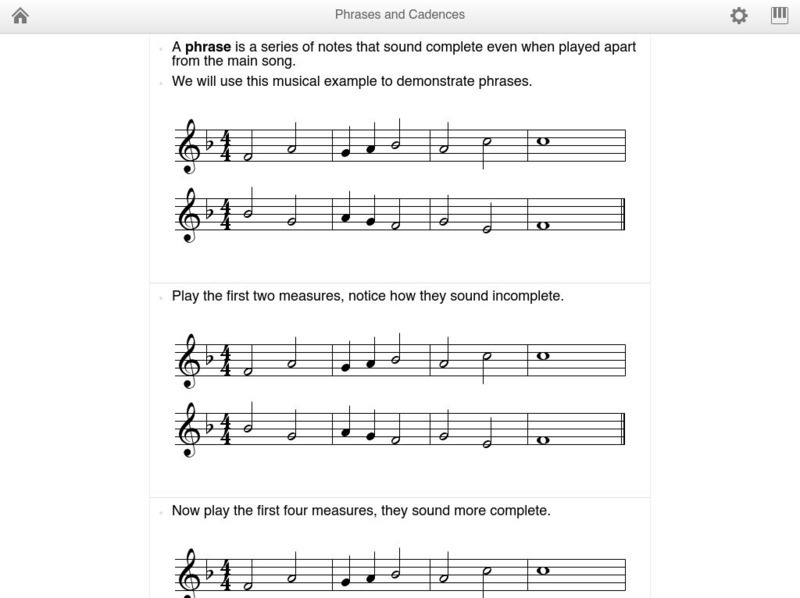Curated OER
Teaching Improvisation to Young Students in a Music Technology Lab Using a Sequencer
You'll need to be a little tech savvy to teach this music instructional activity. Pupils will attempt to play along with an accompaniment piece you've created using music software. They will be assessed on their performance and ability...
Curated OER
Reviewing Good Playing Habits
The string section of your school orchestra can get a proper form make-over by incorporating this lesson. They reestablish proper playing form, posture, and sound as they compose an essay on how to maintain good playing habits during...
Curated OER
Independent Harmonies
Independent harmonies, homophonic music, intervals, and melody are all part of music theory and practice. Prepare your budding musicians for the big time with these activities focused on playing with accompaniment. This instructional...
Curated OER
Star Spangled Banner: For Orchestra
Middle schoolers practice playing "The Star Spangled Banner" while focusing on phrasing. They work with the instructor to mark the lyrics and music, then play the song using the phrasing indicated. Several cross-curricular extension...
Curated OER
Focus on Harmony
Harmony is the focus of this band lesson plan. Upper graders play the Star Spangled Banner, while focusing on harmony, chords, and musical voice. This lesson plan includes several suggested cross-curricular activities.
Curated OER
Focus on Form
Young musicians discuss musical form found in the song, The Star Spangled Banner. They review their parts for the song then practice playing it as a group. Cross-curricular activity suggestions are included.
Curated OER
Exploring Pulse & Rhythm
When we play music, we count beats both high and low. This introductory music activity explores tempo and rhythm. Learners will follow along as they clap to the beat, they clap high in the air and low. A very good introductory lesson.
Curated OER
Musical Terms
Are you starting a recorder lesson with your elementary students? Use this helpful slide-show, perfect for introducing basic music terms such as tempo, dynamics, pitch, and duration. Each slide provides a definition and example of the...
Curated OER
Exploring Pentatonic Scales
What better way to teach pentatonic scales than to have them playing while you define them? This slide-show includes simple yet correct descriptions of five note scales in C, G, and F major as well as examples for learners to hear.
Curated OER
"Eine Kleine Nachtmusik"
Mozart was an amazing composer and "Eine Kleine Nachtmusik" was one of his best-loved orchestral pieces. This handout provides a brief description of the instruments for which it was written, and how each section and part should be...
Curated OER
Home Music Practice Checklists
Music is great, but in order to play really well, you have to practice. Here is a printable checklist that will help your music students remember to practice playing their instruments everyday. The daily practice reminder includes a...
Curated OER
Band On Line
In 1996, using the Internet to enhance learning was a new innovation. While the instructional activity here is a bit outdated, it could still provide a basic understanding of how technology can enhance music appreciation. Members of the...
Curated OER
Harmony with Drones
A drone is the simplest of all harmonies, you'll play or sing an example and your class will follow along. They listen to, and then play or sing drones. Two pieces containing drones are included for you to print, pass out, and play.
Curated OER
Focus on Phrasing
The band practices The Star Spangled Banner, while focusing on phrasing. They discuss musical phrasing then practice incorporating it in their performance. Cross curricular extension activities are included.
Curated OER
Learning AB Form: Music
Third grade musicians play Orff instruments while they learn about the AB Form. First they learn part A of a song, then they listen to when the song changes. After they understand the concept of AB form, they learn to play part B. Note:...
Curated OER
Timed Note Identification
Before you can play from sheet music, you need to be able to read it. This timed quiz requires the class to identify as many of the 90 notes as they can. Notes are on a staff in both treble and bass clef.
Music Theory
Music theory.net: Interval Trainer
This online quiz is a fantastic tool to check your knowledge of intervals. Keeps score, and can be customized to fit specific lessons (augmented intervals, diminished intervals, double accidentals.)
Music Theory
Music theory.net: Chord Ear Trainer
This online quiz gives students a chance to recognize triads and seventh chords, by listening to audio clips. Teachers can customize this quiz and print out progress reports.
Music Theory
Music theory.net: Note Duration
A fabulous resource for beginners in music theory! Gives examples and explanations of the sixteenth note, eighth note, quarter note, half note, and whole note. The last page on this site provides a chart showing the relationship of each...
Music Theory
Music theory.net: Rest Duration
A wonderful resource for teachers and students! Gives examples and explanations of rests and how they affect the sound of a musical piece. Simple illustrations and explanations make this animated site easy to follow.
Music Theory
Music theory.net: Dots and Ties
A terrific resource for beginners! Gives examples of dots and ties, and explains how they are used. Simple illustrations and explanations make this animated site easy to follow. By MusicTheory.net.
Music Theory
Music theory.net: Simple and Compound Meter
Examples of simple and compound meters, as well as explanations of the terms duple, triple, and quadruple. Plenty of illustrations accompany this terrific resource. By MusicTheory.net.
Music Theory
Music theory.net: Phrases and Cadences
An explanation of phrases and cadences with illustrated examples. Also provides audio clips, and a printable chart at the end of the lesson. By MusicTheory.net.
Music Theory
Music theory.net: Odd Meter
This site gives a brief definition of an odd meter. Use the arrows at the bottom to navigate. Provides illustrations and a printable chart.

























